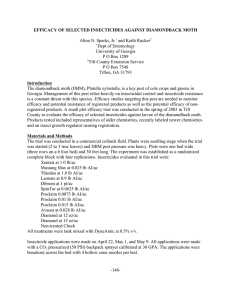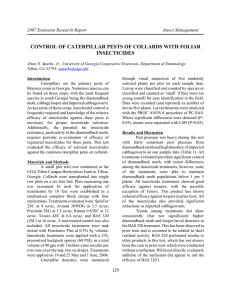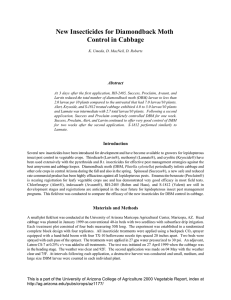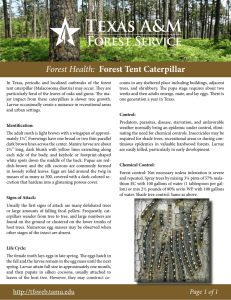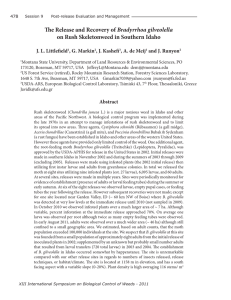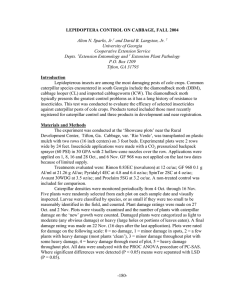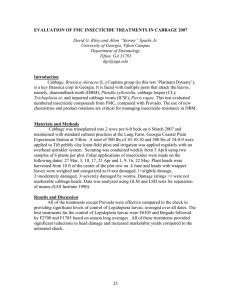FIELD EVALUATION OF INSECTICIDE RESISTANCE IN MANAGEMENT 2007 Extension Research Report
advertisement
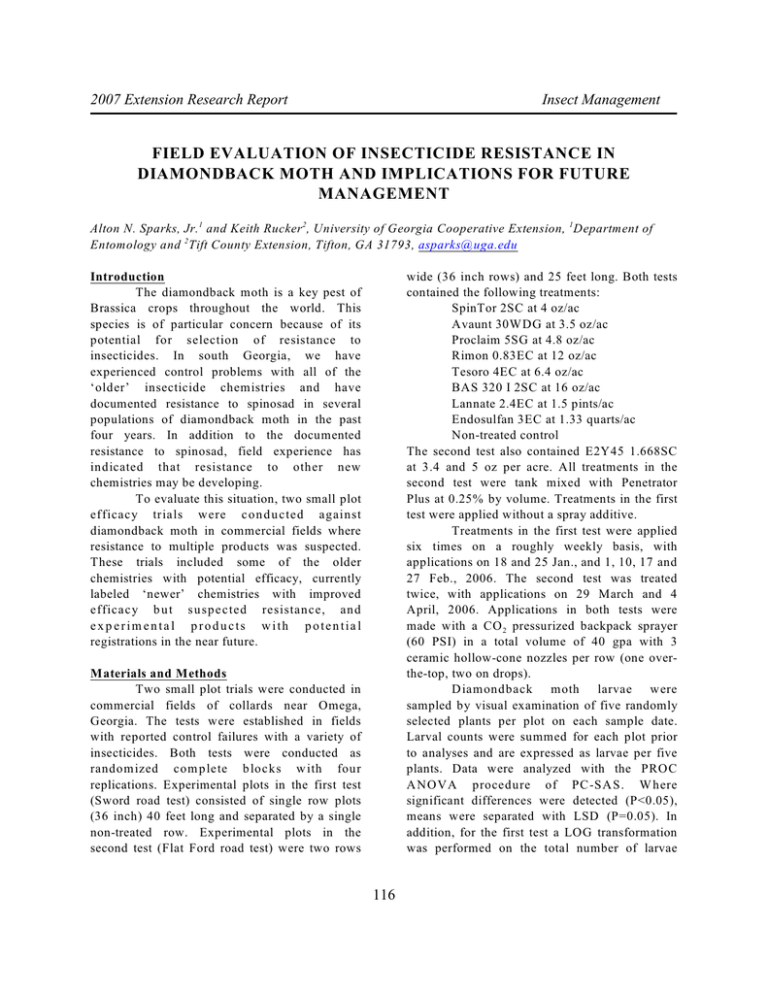
2007 Extension Research Report Insect Management FIELD EVALUATION OF INSECTICIDE RESISTANCE IN DIAMONDBACK MOTH AND IMPLICATIONS FOR FUTURE MANAGEMENT Alton N. Sparks, Jr.1 and Keith Rucker 2, University of Georgia Cooperative Extension, 1Department of Entomology and 2 Tift County Extension, Tifton, GA 31793, asparks@uga.edu wide (36 inch rows) and 25 feet long. Both tests contained the following treatments: SpinTor 2SC at 4 oz/ac Avaunt 30WDG at 3.5 oz/ac Proclaim 5SG at 4.8 oz/ac Rimon 0.83EC at 12 oz/ac Tesoro 4EC at 6.4 oz/ac BAS 320 I 2SC at 16 oz/ac Lannate 2.4EC at 1.5 pints/ac Endosulfan 3EC at 1.33 quarts/ac Non-treated control The second test also contained E2Y45 1.668SC at 3.4 and 5 oz per acre. All treatments in the second test were tank mixed with Penetrator Plus at 0.25% by volume. Treatments in the first test were applied without a spray additive. Treatments in the first test were applied six times on a roughly weekly basis, with applications on 18 and 25 Jan., and 1, 10, 17 and 27 Feb., 2006. The second test was treated twice, with applications on 29 March and 4 April, 2006. Applications in both tests were made with a CO 2 pressurized backpack sprayer (60 PSI) in a total volume of 40 gpa with 3 ceramic hollow-cone nozzles per row (one overthe-top, two on drops). D iam ondback moth larvae were sampled by visual examination of five randomly selected plants per plot on each sample date. Larval counts were summed for each plot prior to analyses and are expressed as larvae per five plants. Data were analyzed with the PROC A NOVA procedure of PC -SA S. W here significant differences were detected (P<0.05), means were separated with LSD (P=0.05). In addition, for the first test a LOG transformation was performed on the total number of larvae Introduction The diamondback moth is a key pest of Brassica crops throughout the world. This species is of particular concern because of its potential for selection of resistance to insecticides. In south Georgia, we have experienced control problems with all of the ‘older’ insecticide chemistries and have documented resistance to spinosad in several populations of diamondback moth in the past four years. In addition to the documented resistance to spinosad, field experience has indicated that resistance to other new chemistries may be developing. To evaluate this situation, two small plot efficacy trials w ere c o n d u cted against diamondback moth in commercial fields where resistance to multiple products was suspected. These trials included some of the older chemistries with potential efficacy, currently labeled ‘newer’ chemistries with improved effica c y b u t s u s p e c ted resistan ce, an d exp erim ental products with potential registrations in the near future. Materials and Methods Two small plot trials were conducted in commercial fields of collards near Omega, Georgia. The tests were established in fields with reported control failures with a variety of insecticides. Both tests were conducted as random ized com p lete b locks w ith four replications. Experimental plots in the first test (Sword road test) consisted of single row plots (36 inch) 40 feet long and separated by a single non-treated row. Experimental plots in the second test (Flat Ford road test) were two rows 116 collected per plot after the first week to aid in statistical separation (some treatments had extreme variability; the first week counts were dropped to allow for slow activity of some products). In the second test, a visual plot rating was conducted on 14 April. Plots were examined for damage and rated on a 1 to 5 scale as follows: 1 = excellent control, 2 = good control, 3 = damage suppression but inadequate; 4 = some suppression, 5 = no control. Damage ratings were analyzed similar to the larval counts. DBM populations did not significantly differ among treatments on the two sample dates after the first application (Table 2). On the first sample (2 days after application), most products would not be expected to provide significant suppression because of slow mortality associated with their modes of action. The lack of differences on the second sample date (3 April) likely resulted from a large influx of DBM into the test as evident by the general increase in populations across all treatments. The largest differences occurred on the last sample date, with BAS 320 I, E2Y45, Tesoro and Proclaim providing significant reductions in populations as compared with the non-treated control. Proclaim, Tesoro and E2Y45 were the only treatments that reduced populations to 1 larvae per plant or less. Similar trends were seen in the plot efficacy ratings. The only treatments that averaged a rating of less than 2.5 (2 = good control, 3 = inadequate) were E2Y45 (high rate only), Tesoro and Proclaim. It is of interest that Lannate preformed poorly in the second test. Control of diamondback larvae in the area where these tests were conducted was reported to be poor with a variety of insecticides. Prior to establishment of the first test, the field had been treated multiple times w ith S p in T o r, A v au n t, P ro claim , B .t. insecticides and pyrethroids. Control was entirely inadequate. Based on the results of this study, the producer introduced Lannate into his insecticide rotation and obtained good control (the grower stated he had not used Lannate in several years). Lannate appeared to work well for several applications but control began to slip at the end of crop production. The field in which the second test was conducted was also part of a large demonstration. Prior to establishment of the test and demonstration, the producer had treated with SpinTor, B.t.s, Lannate and pyrethroids. It was obvious from field experience and test results that Lannate no longer provided suppression of this population; thus providing an excellent demonstration of selection pressure. Proclaim was identified as the one registered product that should provide adequate control. Proclaim was immediately introduced into the insecticide rotation along Results and Discussion In the first test, Sword Road test, DBM populations declined after initiation of the test and minor differences occurred within the first few weeks (Table 1). Populations increased after mid-February and some significant differences were detected, but high variability prevented statistical separation of most treatments. Resistance to SpinTor was evident, with less than 50 percent control on the last three sample dates. Control with Avaunt was variable, ranging from about 50 to 75%. Based on earlier studies, Avaunt was expected to provide over 90% control even in small plot tests. Proclaim (expected to provide over 90% control) performed well, but also provided less control than expected. Lannate and Endosulfan actually performed better than expected, as severe resistance to both p ro d u cts h as been documented. Rimon provided poor control at the end of this study. BAS 320 I provided variable results, possibly because of short residual activity and lack of a tank mix surfactant recommended for this product, but control was inadequate under the conditions of this test. Tesoro performed well in this test and was the on ly in secticid e th at m ain tain ed D B M populations at or below 1 larvae per 5 plants after the first week of the study, with populations below 0.5 larvae per 5 plants on 8 of the last 10 sample dates. Evaluation of the total larvae collected per plot after the first week clearly shows Tesoro providing the greatest suppression, with a 95% reduction as compared with the check. In the second test, Flat Ford Road Test, 117 with continued use of B.t.s and adequate control was obtained (aided by heavy rains). While Proclaim provided adequate control, the level of control was less than expected based on prior data. Heavy reliance on this single product is likely to result in resistance relatively soon. Several new insecticides with efficacy against the diamondback moth were identified in these studies. BAS 320 provided good control of larvae but was somewhat inconsistent under conditions of this test. Experience with this product indicates that a spray adjuvant assists control and that the product likely has relatively short residual activity. Both Tesoro and E2Y45 provided good control of diamondback moth larvae. W ith additional registrations of efficacious insecticides and renewed emphasis on proper rotation of modes of action, hopefully producers in south Georgia can manage diamondback moth populations to avoid both economic injury and insecticide resistance. Table 1. Diamondback moth larvae per five plants, Sword Road Collards Test, Omega, Georgia, 2006. Number of DBM larvae per 5 plants Treatment 20 Jan 24 Jan 27 Jan 31 Jan 6 Feb 9 Feb 13 Feb Check 3.75 a 1.75 a 1.00 a 0.50 a 3.00 a 2.50 a 1.25 a SpinTor 1.75 a 2.75 a 1.50 a 1.00 a 2.00 a 1.50 a 0.00 a Avaunt 1.75 a 2.00 a 0.25 a 0.00 a 0.25 a 0.75 a 1.25 a Proclaim 2.50 a 1.00 a 0.25 a 0.75 a 1.50 a 1.25 a 1.25 a Endosulfan 1.50 a 1.00 a 0.00 a 1.00 a 1.25 a 0.25 a 0.50 a Lannate 1.50 a 1.00 a 0.50 a 0.75 a 0.50 a 0.50 a 0.75 a Rimon 2.50 a 2.50 a 0.75 a 1.75 a 1.00 a 2.00 a 2.25 a BAS 320 3.75 a 2.25 a 2.25 a 0.50 a 0.50 a 1.25 a 1.00 a Tesoro 2.50 a 1.25 a 0.50 a 0.50 a 0.00 a 0.00 a 0.25 a Numbers within columns followed by the same letter are not statistically different (LSD, P=0.05). 118 Table 1 (cont’d). Diamondback moth larvae per 5 plants, Sword Road Collards Test, Omega, Georgia, 2006. 16 Feb 20 Feb Number of DBM larvae per 5 plants Total After 24 Feb 28 Feb 3 March 1st week Check 8.00 a 12.00 a 12.00 a 11.50 a 16.25 a 68.00 a 68.00 a SpinTor 2.25 b 5.00 b 6.75 a 10.50 a 10.00 ab 40.50 ab 40.50 ab Avaunt 1.50 b 2.75 bc 6.25 a 4.75 ab 2.75 b 20.50 bcd 20.50 bcd Proclaim 1.25 b 2.25 bc 3.50 a 1.75 b 3.00 b 16.75 bcd 16.75 bcd Endosulfan 0.25 b 1.75 bc 3.75 a 1.75 b 1.50 b 12.00 bcd 12.00 cd Lannate 1.00 b 1.00 c 1.25 a 1.75 b 2.25 b 10.25 cd 10.25 d Rimon 1.25 b 3.75 bc 7.00 a 7.25 ab 9.75 ab 36.75 bc 36.75 ab BAS 320 6.50 a 0.75 c 5.00 a 2.50 b 5.25 b 25.50 bcd 25.50 bc Tesoro 0.00 b 0.00 c 0.75 a 0.00 b 1.00 b 3.00 d 3.00 e Treatment Total After 1st week* Numbers within columns followed by the same letter are not statistically different (LSD, P=0.05). * Statistical separation in this column is based on a LOG transformation of the data. Table 2. Diamondback moth larval densities and plot efficacy ratings, Flat Ford Road Collards Test, Omega, Georgia, 2006. DBM larvae per 5 plants Treatment Plot rating 14 April 31 Mar 3 April 6 April 10 April Check 4.50 a 20.00 a 31.25 a 42.50 a 3.75 a Rimon 3.50 a 16.00 a 24.25 ab 42.75 a 3.75 a Avaunt 2.75 a 15.50 a 12.75 bcde 21.50 abc 2.88 bc Lannate 1.50 a 14.25 a 16.00 bcd 29.50 ab 3.38 ab BAS 320 I 3.50 a 13.25 a 7.75 de 15.50 bc 3.50 a Endosulfan 5.00 a 13.25 a 20.00 abc 28.25 ab 3.63 a E2Y45 3.4oz 4.50 a 12.25 a 10.00 cde 4.25 c 2.63 cd SpinTor 4.25 a 10.50 a 18.50 bcd 25.25 abc 2.75 cd E2Y45 5oz 3.25 a 10.00 a 11.75 cde 4.00 c 2.25 d Tesoro 2.75 a 8.75 a 6.00 de 4.50 c 2.38 cd Proclaim 3.50 a 7.75 a 3.50 e 5.00 c 2.25 d Numbers within columns followed by the same letter are not statistically different (LSD, P=0.05). 119
